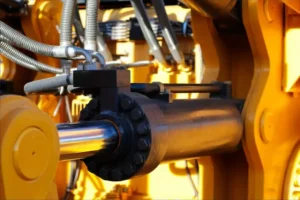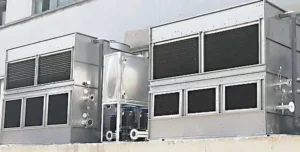بوتقة الفرن التعريفي عبارة عن جهاز صناعي خاص يستخدم للتسخين التعريفي, often used to heat metals and other conductive materials. The induction crucible adopts the principle of induction heating and uses the eddy current generated by electromagnetic induction to heat the material. This device mainly consists of the following parts:
- بوتقة: A crucible is usually a container that holds the material to be heated. It is usually made of conductive material, such as a metal crucible. In an induction crucible, the bottom of the crucible is part of the induction coil, which is a key part of the heating.
- ملف التعريفي: The induction coil of the induction crucible is a conductive coil wound into a disk or spiral shape, usually made of copper or other excellent conductive materials. When AC current is passed through an induction coil, it creates a changing electromagnetic field.
- RF power source: The induction crucible needs to be connected to a radio frequency (RF) power source. This power source provides high-frequency AC current, usually in the range of tens of kilohertz to several megahertz. This high-frequency current passes through the induction coil, generating eddy currents that inductively heat the bottom of the crucible.

The working principle of the induction crucible is based on Faraday’s law of electromagnetic induction. When high-frequency current passes through the induction coil, a changing magnetic field creates eddy currents within the crucible. These eddy currents induce heating in the material, causing the material to increase in temperature. The main advantage of induction crucibles is the ability to achieve contactless heating, making them ideal for applications that require precise temperature control and high-temperature heating, such as industrial processes such as metal smelting, تلبد, and quenching. Induction crucibles are also commonly used in laboratory research and materials analysis to provide precise heating and cooling control.
How many types of crucibles are there?
- Ceramic crucible: Ceramic crucible is usually made of ceramic materials, such as alumina, quartz, borate, إلخ. They are high-temperature resistant and chemically inert, making them suitable for melting, تلبد, and sample analysis at high temperatures.
- Metal crucible: Metal crucible is usually made of metal materials, such as platinum, النيكل, الفولاذ المقاوم للصدأ, إلخ. They are used for metal smelting, quenching and high-temperature testing at high temperatures and have good thermal conductivity.
- Quartz crucible: Quartz crucible is usually used for thermal analysis experiments at high temperatures, such as differential scanning calorimetry (DSC) and thermogravimetric analysis (TGA). They are inert to many chemicals and suitable for research at high temperatures.
- Glass crucible: A glass crucible is usually used for one-time experiments or lower-temperature applications. They are generally not suitable for high temperatures or strong acid and alkali conditions.
- Grinding crucibles: These crucibles are often specially designed to grind the sample into a powder form. They are commonly used for sample preparation and particle analysis.
- Gas collection crucibles: These crucibles are designed to collect gas samples in experiments, typically for analytical methods such as gas chromatography.
- Deep cup crucible: The deep cup crucible has a deep and narrow cup shape and is suitable for the measurement of liquid samples, such as solubility determination and solution thermodynamics research.
- Aluminum crucible: Aluminum crucible is usually used for sample combustion analysis, such as ash content determination.
Crucible design and manufacturing
Design features and shapes:
- Shape: The shape of the induction furnace crucible is usually cylindrical with a flat bottom to ensure stable placement in the induction coil. This shape helps to evenly distribute the electromagnetic field of the induction heating.
- مقاس: The size of the crucible will vary depending on the size of the induction furnace and the specific application. Small induction furnaces may use smaller diameter crucibles, while larger induction furnaces require larger crucible capacities to accommodate more work materials.
- Wall thickness: The wall thickness of the crucible is usually determined based on the type of material being processed and the temperature requirements. High-temperature processes often require thicker walls to resist thermal stress.
structure:
- Material selection: Induction furnace crucibles are usually made of high-temperature refractory materials. Common materials include graphite, ceramics and quartz. Each material has its own unique advantages and application areas.
- Coating: Sometimes the interior of a crucible may be coated with a protective coating to improve its corrosion resistance and reduce interaction between the material and the crucible walls.
- Bottom design: The bottom of the crucible is usually flat to ensure uniform heat conduction and easy placement in the induction coil. The bottom may be specially designed to accommodate the furnace floor induction coil.
Manufacturing process:
The crucible manufacturing process involves the following steps:
- Material preparation: Select the appropriate crucible material, usually a high-temperature stable material like graphite. The material should have the required thermal conductivity and mechanical strength.
- تشكيل: Forming the material into the desired shape of the crucible, usually cylindrical. This can be done by extrusion, يصب, or other forming processes.
- Sintering and processing: Materials such as graphite often require sintering to improve their thermal stability. Ceramic crucibles may require high-temperature sintering to achieve the desired structure and properties.
- Coating: If required, apply a coating to the interior of the crucible to enhance corrosion resistance.
- Testing and quality control: Conduct quality testing of crucibles to ensure they meet specifications and performance requirements.
- Delivery and installation: The manufactured crucible is delivered to the induction furnace manufacturer or end-user and then installed into the induction furnace.
Thermal properties of the crucible
1. Thermal conductivity:
-تعريف: Thermal conductivity is the ability of a material to conduct heat. Materials with high thermal conductivity can transfer heat from the induction coil to the working material more efficiently.
-Importance: In induction furnaces, the work material needs to be heated evenly. Crucibles with good thermal conductivity can distribute heat more evenly, ensuring that materials are heated evenly, thereby reducing thermal stress and improving the quality of the work material.
2. High-temperature resistance:
-تعريف: High-temperature resistance is the ability of a material to maintain its structural integrity and performance under high-temperature conditions.
-Importance: Induction furnaces are typically used in high-temperature applications where temperatures can reach thousands of degrees Celsius. The crucible must be able to withstand high temperatures to ensure that the material does not melt, soften, or crack, thus maintaining the stability of the work process.
3. Chemical stability:
– تعريف: Chemical stability is the ability of a material not to undergo undesired chemical reactions when in contact with the work materials being processed.
-Importance: Crucibles are commonly used to process materials of various chemical compositions, including metals, alloys, and chemicals. Chemical stability is a key factor in ensuring that the crucible does not react undesirably with the work material, preventing material contamination or corrosion of ceramic crucibles.
These thermal properties are critical to the operation of induction furnaces and material handling processes. If the thermal conductivity of the crucible is poor, it may cause uneven heating of the material and increase thermal stress, thus affecting the quality of the work material. Crucibles with poor temperature resistance may lose stability at high temperatures, leading to malfunctions and shutdowns. في نفس الوقت, chemical instability can cause unnecessary material contamination and reduce product quality.
لذلك, the selection of crucible materials with good thermal conductivity, مقاومة درجات الحرارة العالية, and chemical stability, as well as the correct crucible design, are very important for the performance of the induction furnace and the success of material processing.

Induction crucibles have always been an indispensable tool in science, industry, and laboratories. Its unique heating principle, superior material properties, and wide range of applications make it a key factor in experimental accuracy and efficiency. We have taken an in-depth look at how induction crucibles work, material selection, manufacturing processes, and how to use them.
The high-temperature resistance, chemical inertness, and thermal conductivity of the induction crucible make it play an irreplaceable role in the fields of metal smelting, تلبد, thermal analysis, and materials research. It provides scientists, engineers, and researchers with powerful tools to solve complex problems, conduct precise experiments, and drive innovation.
In the future, the field of induction crucibles will continue to develop. New technological and material innovations will further improve the performance of induction crucibles, expand their application areas, and push the frontiers of experimental and industrial processes.
Whether you are conducting research in the laboratory or seeking high-temperature solutions in industrial production, induction crucibles will continue to play a key role in the development of different fields. We encourage you to gain a deeper understanding of the potential of induction crucibles and choose the specific type that suits your needs, allowing for more precise experiments and more efficient industrial production.
The induction crucible is a key tool at the forefront of science and a driving force for experimental success and innovation. We look forward to achieving more milestones in its development and contributing more exciting achievements to future science and engineering.








